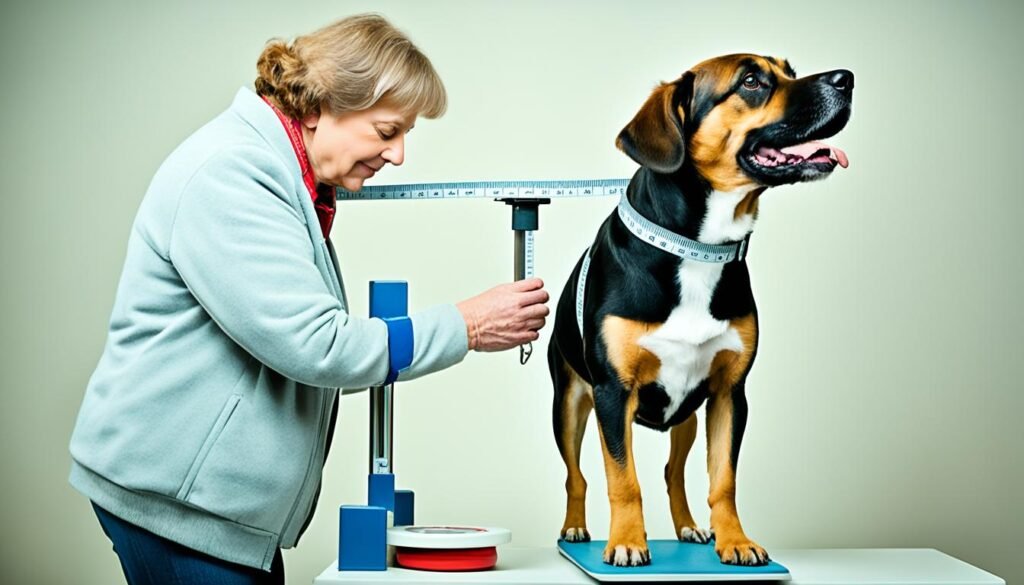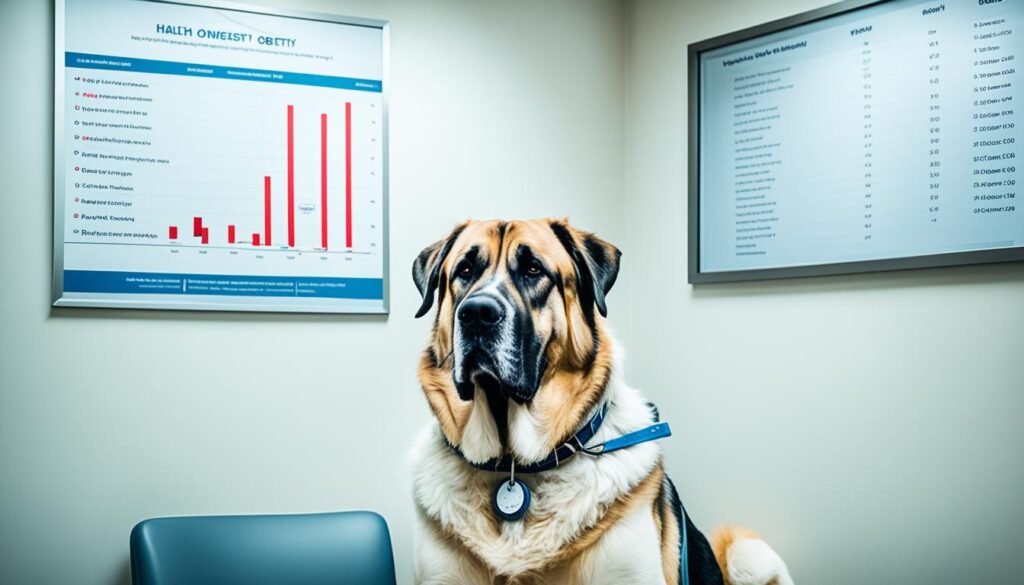As a devoted dog owner, I’ve always cherished the unconditional love and companionship my furry friend has brought into my life. But recently, I’ve noticed that my pup seems a little heavier than usual. Am I just imagining things, or could my beloved canine be carrying some extra weight? The health and well-being of my dog are my top priority, so I knew I needed to find out for sure. This guide will help me determine if my dog is overweight and provide practical tips to get them back on track to a healthy weight.
According to a 2018 survey by the Association for Pet Obesity Prevention, a staggering 55.8% of dogs in the United States are considered overweight or obese1. Carrying those extra pounds can put my dog at risk for a host of serious health issues, from canine diabetes and heart problems to painful arthritis1. As a responsible pet parent, I need to be proactive in ensuring my furry companion maintains a healthy weight.
Key Takeaways
- Approximately 55.8% of dogs in the U.S. are overweight or obese1.
- Excess weight can lead to serious health problems like diabetes, heart issues, and arthritis1.
- A healthy weight for a dog varies by breed, but most sighthounds should have visible ribs1.
- Gradually increasing exercise and reducing food intake can help dogs lose weight safely1.
- Consulting a veterinarian is crucial for developing a personalized weight loss plan2.
Signs Your Dog Might Be Overweight
Monitoring your dog’s weight and body condition is crucial for their overall health and well-being. There are several signs that may indicate your furry friend is carrying a few extra pounds3.
Check Your Dog’s Body Shape
When looking at your dog from above, if they appear round and oval-shaped, it’s likely they are overweight3. On the other hand, if your dog has a defined waist toward the rear and a straight build down the sides, they are probably at a healthy weight3.
Feel for Your Dog’s Ribs
Another way to assess your dog’s weight is by feeling their ribs. If you can easily feel their ribs without having to press hard, your dog is at a healthy weight3. However, if it’s difficult to feel their ribs because there is too much fat covering them, your dog is likely overweight3.
In addition to visual cues, there are other signs that may indicate your dog is carrying extra weight, such as panting while walking slowly, walking at a slower pace than usual, and needing more naps throughout the day3.
Maintaining a healthy weight is crucial for your dog’s wellbeing. Regular exercise, a balanced diet, and routine veterinary check-ups can help ensure your furry friend stays in top shape34.
| Dog Body Condition | Ribs Visibility | Waist and Abdomen |
|---|---|---|
| Ideal Weight | Ribs can be easily felt without much fat covering them | Well-defined waist and abdominal tuck |
| Overweight | Ribs are difficult to feel due to excess fat | Rounded body shape, no visible waist |

If you’re concerned about your dog’s weight, it’s best to consult with your veterinarian. They can provide personalized guidance and recommendations to help your furry friend achieve and maintain a healthy weight54.
How to Tell if a Dog is Overweight
Determining if your canine companion is overweight can be a bit tricky, but there are a few reliable methods to assess their body condition. The best way to know for sure is to schedule a weigh-in at your veterinarian’s6. Your vet can then evaluate your dog’s size, breed, and physical attributes to determine if they fall within a healthy weight range.
One helpful tool is the body condition score chart, which ranges from 1 (severely underweight) to 9 (extremely overweight)6. The ideal body condition score for most dogs is between 4 and 5, indicating a healthy weight. To assess your dog at home, you can gently feel their ribs and spine – you should be able to easily feel them, but they shouldn’t be protruding6.
Another method is to observe your dog’s body shape from above and the side. An overweight dog will have a rounded, barrel-shaped torso and may have a sagging abdomen.6 In contrast, a dog at a healthy weight will have a more defined waistline when viewed from above, and their abdomen should tuck up slightly when seen from the side.
| Indicator | Healthy Weight | Overweight |
|---|---|---|
| Body Shape | Defined waistline, tucked abdomen | Rounded, barrel-shaped torso, sagging abdomen |
| Ribs and Spine | Easily felt, not protruding | Difficult to feel, may be hidden by fat |
| Body Condition Score | 4-5 out of 9 | 6 or higher out of 9 |
Regular check-ups with your veterinarian are key to maintaining your dog’s optimal health and preventing canine obesity6. By staying vigilant and taking proactive steps, you can ensure your furry friend enjoys a long, healthy, and active life.

Health Risks of Canine Obesity
Carrying extra weight can take a significant toll on a dog’s overall health and well-being. According to the latest data, up to 65% of dogs in the United States are considered overweight or obese7. This excess weight can lead to a host of serious health issues, including diabetes, skin problems, heart problems, joint problems, kidney disease, arthritis, certain cancers, liver problems, mobility issues, breathing problems, and high blood pressure7.
The impact of obesity is especially pronounced in certain dog breeds. For instance, extra pounds for toy breed dogs can have a significant impact, with just three extra pounds being equivalent to gaining approximately 30 pounds for a human8. Large dog breeds may even develop orthopedic issues while still growing if they become overweight7.
Obesity in dogs can have far-reaching consequences. Studies have shown that being just 10% overweight can decrease a dog’s lifespan by one-third and predispose it to various health issues8. In fact, a clinical trial revealed that obese dogs with osteoarthritis experienced a significant decrease in lameness from weight loss starting at just 6.10% of their body weight8.
Maintaining a healthy weight is crucial for a dog’s overall well-being. According to the Association for Pet Obesity Prevention, more than 50% of dogs in North America are considered overweight9. Obesity in dogs can also indicate underlying diseases like hypothyroidism and Cushing’s disease, making it essential to work closely with a veterinarian to address the issue9.

By staying vigilant and taking proactive steps to manage a dog’s weight, pet owners can help their furry friends avoid the numerous health risks associated with canine obesity789.
Conclusion
If your veterinarian determines that your dog is overweight, they will work with you to develop a comprehensive weight-loss plan10. This typically involves reducing calorie intake, increasing exercise, and making targeted dietary changes. With the guidance and support of your veterinary team, and a commitment to a healthier lifestyle, your dog can lose weight and avoid or even reverse many of the serious health issues associated with canine obesity.
Maintaining a healthy weight is essential for your dog’s overall well-being11. By taking proactive steps to “how to help dog lose weight,” you can help your furry companion live a longer, happier, and more active life. Remember, gradual changes are key, as rapid weight loss can be detrimental12. With patience, consistency, and the right approach, you can guide your dog to a healthier future.
The key is to work closely with your veterinarian to develop a personalized plan that addresses your dog’s specific needs and helps them achieve a healthy weight101112. By doing so, you can not only improve your dog’s physical health but also enhance their quality of life and longevity.




